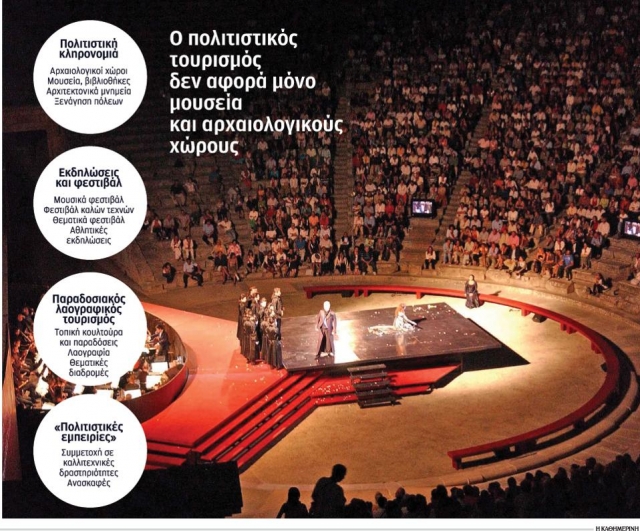Pictures www.kathimerini.gr
Greece is rich in cultural heritage but suffers from the outdated policy on its utilization. A study has shown that the country lags behind other countries in terms of revenues and measures for the attraction of tourists.
In 2012, the Union of tourist companies in Greece sent the study to the Ministry of Culture. It shows how the utilization of tourist sites, which brought less than 3 euro per visitor in 2011, can be reorganized. There was no reaction on the part of the Ministry. Thus, revenues from visitors were low in 2013, too.
According to the study, carried out by Makinzi, on average, revenues from a visitor in Greece totalled only 6.1 euro in 2011 compared to 19.7 euro on average in Europe.
Archaeological sites today are managed by the Fund for archaeological revenues and resources. This is an organization established in 1977 under the conditions of that time. It manages ticket offices, museum venues and shops, as well as the production of replica. There are also two laboratories which are managed by the fund, but its activity is not limited to this. The result is terrible.

Figures are indicative enough. For example, 86% of revenues from tourist sites and museums in Greece even today come from entry tickets (there is no such thing as electronic tickets). In England, for example, this percentage (from revenues from tickets) covers only 26% of revenues, and in France - even less.
What happens there? The majority of revenues come from shops. In Greece, only 0.2 euro came from sales in shops on sites in 2011. In France, the amount was 6.5 euro.
This difference is explained by the fact that the strategy - if any - of managers of Greek sites is not based on the "experience" of each visitor, but on an "exhibit/discovery." However, this view is consistent with the logic of the 1980s, and it has been abandoned in Europe for many years.
It should be clear that the private organization of tourist companies does not suggest the closure of the state fund. Such organizations are public everywhere. What does it suggest? It suggests that it should have a different structure, which should be based on the following:
• Products and services. These can include a diverse policy on tickets (on the internet, via subscription or issuance of an annual ticket, as well as a poly-ticket of various prices), combined with donation packages, creation of members, as well as an indigenous renewal of the product policy, with many and various products which will be distributed electronically.
• A common policy of promoting, through private channels and the Internet. Today, most websites of venues are obsolete and not interactive, and offer an experience not because of the fund, but because of another archaic organization which was closed.
• Improved experience of visitors with the appointment of a manager who should be responsible for the overall experience of the visitor, via continuous monitoring of visitors’ satisfaction, as well as via continuous qualification of staff.
Increase of revenues
The union of tourism companies believes that the proceeds of the cultural heritage can be more than 300 million euro within five years, with the increase of revenues from tickets to 130 million euro from 41 million euro today, from products (from 1 million euro today to 95 million euro), from services (from 3 million euro to 50 million euro), from subscriptions (from zero to 20 million euro), and from sponsorship of individuals (from 3 million euro to 20 million euro).
These structural changes must be supported by 20-30 people who should deploy the fund and present new activities. Today, the fund has an Administrative Directorate, a Press Department and a Building Maintenance Department. However, their employees do not deal with the ways in which to increase revenues, and for them it is enough that archaeological sites are maintained and shown. A similar organization in France has 6 channels for selling tickets online, by phone, fax, or conventional postal delivery services, as well as electronic stores, and supermarkets.
Forget castings, apps have come
The ticket for Versailles is 18 euro, for the Colosseum - 12 euro, for the Prado and the Louvre - 12 euro, in Mycenae - 8 euro, for the National Archaeological Museum – 7 euro, for the Acropolis Museum - 5 euro, i.e. Greek tickets are cheaper, since the country has become frozen in the politics of the '80s.
What does the study suggest? Reduction of castings/replicas, which are now more than 300, to only 50 or a maximum of 100, based on data on the demand and attendance of objects. It also suggests the development of digital walks and the use of apps for smartphones. Before the 2004 Olympics, there were such digital walks for Olympia but they are no longer functioning.
The same study asks questions about the awareness of visitors or likely visitors of Greece as a cultural destination. Based on 2008 data, 42% know the country, 22% have visited it, but only 12% are likely to return. The corresponding percentages in Spain are 43%, 23% and 20%, respectively and in Italy - 47%, 25% and 23%. France (but outside Paris) these are 34%, 15%, and 14% and in Egypt - 47%, 19%, 15%. Of the competing destinations only Turkey has a low rate of awareness - 19%, a low rate of visits (6%) and even lower rate of visitors who want to return (3%).